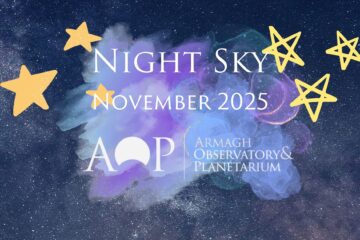Hello again Planetarichums! It’s Stephen here, ready to do my very best to explain some of the upcoming wonders in our night sky as we head into winter and the Christmas holidays.
So, first things first, we’ll talk a little about our celestial neighbour, the Moon. On December 3rd our sky will be illuminated with a full moon, this is normally nothing out of the ordinary – but this month we are getting our only ‘Supermoon’ of the year. This means that the Moon will be near its closest point to Earth when full and so will look a little larger and brighter than normal. Don’t worry though, everything will return to normal and the Moon being the genial satellite that it is, isn’t on a collision course with Earth, as that would somewhat ruin Christmas and that’s just not the sort of behaviour we would expect from our closest space neighbour.
You may have read that the 1st of December heralds the official arrival of winter, but we’re pedants here and are clinging on for a while longer and waiting for the start of the astronomical winter, which begins on the 21st December. This will bring in our shortest day, but don’t get too downhearted, as it will also ring in the start of the holiday season for many and darker nights are generally excellent for star gazing.
Looking further afield we have some very interesting constellations making themselves extremely visible in the darker nights of December. First up, we have one of my favourites, Orion’s Belt, which is the most iconic part of Orion the Hunter. Orion’s Belt should now be very clearly visible in the southwestern sky.

The three bright stars of Orion’s Belt should be very easy to see in the night sky this month. (Credit: Stephen McAvinchey/Stellarium)
Orion is a great constellation for the casual observer, you do not need a telescope or a pair of binoculars to make out the very prominent shape of Orion. It’s simplicity to view is aided by its vast size. Orion also has his mythical companion, Canis Major his hunting dog, according to legend, just below. This constellation is also very straightforward to view unaided as Canis Major contains the brightest star, Sirius, in our night sky. Orion’s other hunting dog, constellation Canis Minor, make up what is commonly known as ‘The Winter Triangle’.

Orion and his dogs in the night sky. The Winter Triangle is made up of the stars Procyon (Canis Minor) Sirius (Canis Major) and Betelgeuse (Orion). (Credit: Heather Alexander/Stellarium)
One thing I have come to learn from reading about the origins of the constellations is that you do not get to be immortalised in the sky without having to put up with a great deal of violence and hardship first. Orion is no different to many others in this regard, although it could be argued that Orion brought quite a bit of this trouble upon himself.
Orion appears in several Greek texts, and according to Hesiod he spent his life involved in very elaborate quarrels with other divine figures. For instance, Orion got drunk one night and made a bit of a scene in Crete (and he won’t be the last to do that), he was punished by its ruler Oenopion with blinding.
Orion’s unfortunate demise also came as a result of his hubris – whilst getting on with his day job and having a bit of a hunt, he threatened to kill every animal on Earth. Mother Earth wasn’t too delighted with this turn of events and sent a scorpion (the imaginatively named ‘Scorpius’) to kill our arrogant friend in the sky. The scorpion succeeded, and joins Orion with its own constellation in the heavens. Poor Orion couldn’t even escape his enemies in the afterlife and will have to look at his killer for an eternity, but at least he has his dogs for company.
Moving on from the grimness of the ancient Greeks, we will be joined this month in the Planetarium by the BBC news team who will be using one of the heritage telescopes in the Observatory to search for Santa. We will be hoping to determine his exact location in the run up to Christmas as the Moon will unfortunately be in its new moon phase on Christmas Eve, so it might be hard to do any Santa tracking without the Moon’s glow. Keep an eye out for us on your television at some point during the news coverage on Christmas Eve for more up to date information about the big man’s whereabouts.
I’ll not keep you any longer, but I would like to thank you for reading and wish you all a Merry Christmas and a Happy New Year. We’ll be back in January with more sad tales of ancient figures in the sky – and I’ll be hoping to stumble across a figure who got immortalised with his or her own constellation as a result of having a nice handy job in an office whilst managing to avoid falling foul of any deities. There’s bound to be a relatable constellation hidden amongst the 88 figures surrounding us somewhere. Failing that, we will be on the lookout for any noteworthy celestial events above us throughout the year.
Merry Christmas!
Article by Stephen McAvinchey, Education Support Officer




1 Comment
The December Night Sky 2017 – MeasurementDataBases for Industry & Science · December 1, 2017 at 17:58
[…] Astronotes Astronotes: Hello again Planetarichums! It’s Stephen again here, ready to do my very best to […]